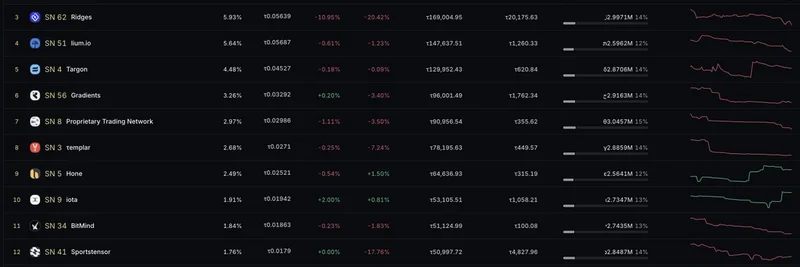In the fast-paced world of decentralized AI, Bittensor's TAO ecosystem is buzzing with activity around its subnet alpha tokens. A recent thread from crypto enthusiast hitesh.eth breaks down the essentials of these 128 tokens, highlighting the competitive landscape where low-emission tokens face delisting as new subnets emerge. If you're dipping your toes into this space, it's crucial to grasp how these mechanics work—especially with a halving event looming that could shake things up.
The Basics of Subnet Alpha Tokens
Subnet alpha tokens, often just called alpha tokens, represent stakes in Bittensor's various subnets—specialized networks within the larger Bittensor ecosystem focused on AI tasks like machine learning models or data processing. To launch a new subnet, creators must lock up around 1,300 TAO tokens, creating a high barrier to entry that ensures only serious projects make the cut.
The pricing of these alpha tokens is straightforward yet clever: it's determined by the ratio of TAO locked in the subnet's reserve to the number of alpha tokens available. As more users stake TAO and swap for alpha tokens, demand pushes the price up. This isn't just about hype; a higher price directly translates to a larger slice of the daily TAO emissions, which are rewards distributed to subnet participants.
Emission Dynamics and the Halving Threat
Emissions are the lifeblood here, with the total daily TAO payout set to halve in the next two months. Subnets with the lowest emission shares risk getting pruned—essentially delisted—when newcomers register. This creates a survival-of-the-fittest environment where miners (those providing computational power) are picky about where they allocate resources. They'll flock to subnets that have achieved product-market fit, meaning they generate real revenue and show sustainable value.
From the thread, it's clear that only a handful—like Ridges, Chutes, and Ilum—currently have trackable revenue streams, though monitoring tools are still limited. This opacity adds to the challenge, making deep research a must before committing.
The Speculative Side and Community Hype
While hitesh.eth emphasizes that these aren't meme coins, there's undeniable speculation at play. Communities rally around promising subnets, discussing use cases, teams, and potential to build hype. This can drive prices higher, attracting more stakers and boosting emissions. However, as the ecosystem grows, it draws in less-informed participants who might end up as "exit liquidity" for early adopters.
Thousands are already chatting about the top 20-30 subnets, and that number could explode. But beware of FOMO—fear of missing out. Entering this arena requires active engagement: watching videos, reading documentation, and joining discussions to truly understand what you're betting on.
Smart Strategies for Newcomers
If you're tempted but overwhelmed, stick to the basics. The thread advises focusing on the top five subnets by emission to minimize risks. Don't chase every shilled token thinking it'll moon; that's a quick way to lose your TAO. Remember, this isn't passive investing—it's a game that rewards knowledge and vigilance.
For those building a knowledge base in blockchain and AI, resources like Bittensor's official docs or community forums on platforms like Discord can be invaluable. And if you're tracking trends, keep an eye on dashboards for emission rankings, even if revenue tracking lags behind.
In essence, the TAO subnet world offers exciting opportunities for those willing to dive deep, but it's not for everyone. As the halving approaches, staying informed could make all the difference in turning speculation into smart strategy. Check out the original thread for more insights straight from the source.


